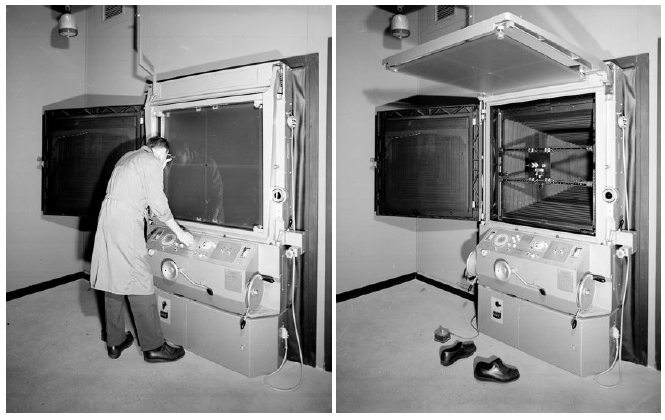As part of our new section Newsblog we have decided to start experimenting with single image texts, picking a different image from one of our photobooks every month. Working towards photographic projects (and their display within photobooks) we spend a long time concerning ourselves with sequencing and narrative. Once the photobook is ready, the sequence ordinately laid inside the book, the narrative functioning correctly, what happens when we focus on the analysis of what and how does one single image communicate? What could this tell us on the functioning of photographic images? Our first pick is a diptych from the recently published second edition of David Fathi’s Wolfgang, which through a recontextualisation of images taken from CERN’s archive tells the strange tale of the Pauli Effect; the myth that Wolfgang Pauli, one of the founders of quantum mechanics, caused unexplainable failures of equipment and experiments just through his mere presence.
We hope you will enjoy the reading!
A man in a white lab coat is peering through a small magnifying lens propped up against a wide opaque screen which recalls the back of a large format camera, his right hand manipulating a button which I suppose aids the act of looking by somehow enhancing the observed matter - to us invisible - on the screen. In the adjacent photograph, the screen of the machine has been lifted and reveals its internal structure without disclosing to the curious viewer the object of observation. The man is gone; all that remains of him are his black leather shoes, emptied in the same position in which we found the man standing in the previous picture.
Sourced from the photographic archives of the European Laboratory for Nuclear Research (CERN, today more often referred to as the European Laboratory of Particle Physics), we do not know whether this diptych has undergone manipulation on behalf of David Fathi. Shot with the use of flash and recording the scene from the exact same point of view, we also do not know whether the pictures were taken with human intervention or if they are the repetitive work of a camera specifically set-up to continuously record what was going on in the room. French scientist, physiologist and chronophotographer E.J.Marey (1830-1904) dreamed about the significance of photographic images in science as the “language of the phenomena itself”. The history of scientific objectivity and its relationship with photographs is crucially imbued with notions of morality in science; whilst the human observer of phenomena was subject to tiredness, fallible attention spans and, fundamentally, subjective interpretation, the mechanical nature of photographic technology was considered to impose objectivity because of the detail and infallibility of the apparatus itself. As pointed out by Lorraine Daston and Peter Galison in Images of Objectivity, “it was not simply that these devices saved the labor of human observers; they surpassed human observers in the laboring virtues: they produced not just more observations, but better observations.”
To contemporary readers, it is immediately clear that what was left out of this moralized equation at the end of the 19th century is the interpretation on behalf of who looks at the image. Whilst scientists at the time were concerned with the subjective interpretation of who is looking at the phenomena, they seemed to be unaware of the of the subjectivity involved in reading photographs. The dream of a realm where images are impervious to subjective interpretation is brutally shattered as soon as the pictures are confronted with a new observer.
Yet, it would be a mistake to believe that the contemporary viewer has been “freed” from the ideal of the objective image, particularly when confronting a scientific archive such as CERN’s. Photographs are still used as evidence, both juridically and in everyday life, testifying the truth of events. For our notion of objectivity is also intrinsically tied to notions of “truth” and “authenticity”, and still has a back-taste of moralized ethics. What are we to make, then, of Fathi’s disappeared scientist in the diptych selected from Wolfgang? We are suspended between a fictional and factual narrative, we do not know whether he has intervened upon the photographs or if they are as he has found them in CERN’s archive. Their aesthetic quality - the flash, the central, fixed perspective - are persuasive in that they hold that ‘amateurial’, not-aestheticized quality which we so often associate with ‘authentic’ photographic material.
Fathi’s photobook ends with an eloquent quote by Richard Feynman: “If you think you understand quantum mechanics, then you don’t understand quantum mechanics”. In a field constellated by awe-striking and incomprehensible phenomenons such as entanglement, wave-particle duality and the double-slit experiment, physicists (and us, when we catch a glimpse of this fabulous field through their simplified explanations) constantly stare into an abyss in which the functionings of time, space and particles seems to be beyond human reach. Scientific American editor Clara Moskowitz stated: “perhaps our only flaw is in trying to use ordinary common sense to grok what is fundamentally an otherworldly universe that does not lend itself to our frail minds.” Perhaps, then, the playful and sometimes eerie photographs arranged in Wolfgang convey a truth which goes way beyond our notions of objectivity; the man in the diptych could have as well disappeared into infinite particles, and the intricate, meddled, incomprehensible but nonetheless real universe of quantum mechanics persists in lying beyond human understanding. What this suggests in regards to our notion of ‘truth’ and its relationship to photographic imagery, then, is that the relationship they bare might be more complex than what we might assume. If truth is narrated through an unreal story, does it make it any less true? Or could the truth perhaps be conveyed with increased accuracy if we rely on alternative narrative devices, rather than placing all our hopes on ‘true events’?
The answer to these questions we leave open to the reader.
Benedetta Casagrande
Photographer, writer, curator


